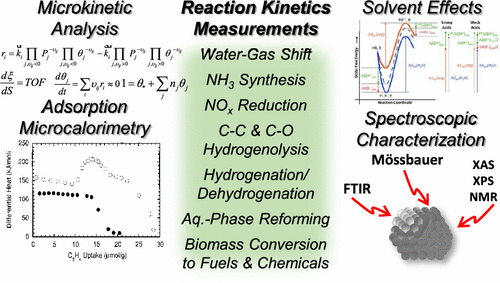当前位置:
X-MOL 学术
›
ACS Catal.
›
论文详情
Our official English website, www.x-mol.net, welcomes your
feedback! (Note: you will need to create a separate account there.)
A Career in Catalysis: James A. Dumesic
ACS Catalysis ( IF 11.3 ) Pub Date : 2021-02-05 , DOI: 10.1021/acscatal.0c05325 Carl R. F. Lund 1 , Bruce Tatarchuk 2 , Nelson Cardona-Martínez 3 , Josephine M. Hill 4 , Marco A. Sanchez-Castillo 5 , George W. Huber 6 , Yuriy Román-Leshkov 7 , Dante Simonetti 8 , Yomaira Pagan-Torres 3 , Thomas J. Schwartz 9 , Ali Hussain Motagamwala 6
ACS Catalysis ( IF 11.3 ) Pub Date : 2021-02-05 , DOI: 10.1021/acscatal.0c05325 Carl R. F. Lund 1 , Bruce Tatarchuk 2 , Nelson Cardona-Martínez 3 , Josephine M. Hill 4 , Marco A. Sanchez-Castillo 5 , George W. Huber 6 , Yuriy Román-Leshkov 7 , Dante Simonetti 8 , Yomaira Pagan-Torres 3 , Thomas J. Schwartz 9 , Ali Hussain Motagamwala 6
Affiliation

|
After 43 years as a professor in the Chemical and Biological Engineering Department at the University of Wisconsin-Madison, James A. Dumesic retired in 2019. Jim is one of the most influential researchers in the field of heterogeneous catalysis. In this Account, we discuss the scientific discoveries that he made and the intellectual processes that he followed during his illustrious career to steer the field of heterogeneous catalysis into new frontiers. He began his career by fundamentally probing the nature of active sites on heterogeneous catalysts using in situ Mössbauer spectroscopy, electron microscopy, FTIR, and kinetic analysis. This tool kit was used to elucidate the “strong metal support interaction” (SMSI) effect. He developed new microcalorimetric tools to measure the energetics of adsorbates on catalyst surfaces. Jim pioneered microkinetic analysis as a tool to describe heterogeneous reaction kinetics incorporating the essential surface chemistry into kinetic analysis, thereby providing a novel strategy for kinetic assisted catalyst design. Density functional theory (DFT) was combined with FTIR and microcalorimetry to elucidate catalytic surface reactions which were then incorporated into microkinetic models. In the early 2000s, Jim developed the aqueous-phase catalytic processing of biomass-derived oxygenates into fuels and chemicals. This led to the development of new processes to make diesel fuel, jet fuel, gasoline, aromatics, and oxygenated chemicals from renewable resources, several of these technologies are in the process of being commercialized. Jim tailored nanostructured catalytic materials by atomic layer deposition and controlled surface reactions to withstand harsh aqueous-phase biomass processing conditions. He used careful selection and tuning of the solvent composition to achieve substantial control over the activity and selectivity of various biomass upgrading reactions and developed a theory to explain these solvent effects. Underlying these discoveries was a thought process that used fundamental surface chemistry to explain the relationship between the structure, properties, and performance of the catalytic system. Leveraging this thought process across many different reaction classes helped to establish both new tools for catalysis research and to develop new processes for the sustainable production of fuels and chemicals.
中文翻译:

催化职业:James A. Dumesic
James A. Dumesic在威斯康星大学麦迪逊分校化学与生物工程系担任教授43年后,于2019年退休。Jim是异相催化领域最具影响力的研究人员之一。在本报告中,我们将讨论他的杰出科学发现以及他在杰出事业中遵循的智力过程,以引导多相催化领域进入新的领域。他的职业生涯始于使用原位Mössbauer光谱学,电子显微镜,FTIR和动力学分析从根本上探索多相催化剂上活性位的性质。该工具套件用于阐明“强金属支持相互作用”(SMSI)的作用。他开发了新的微量量热工具来测量催化剂表面吸附物的能量。Jim率先将微动力学分析作为描述非均相反应动力学的工具,该工具将基本表面化学纳入动力学分析,从而为动力学辅助催化剂设计提供了一种新颖的策略。密度泛函理论(DFT)与FTIR和微量量热法相结合,阐明了催化表面反应,然后将其纳入微动力学模型。在2000年代初期,Jim开发了将生物质衍生的含氧化合物水相催化处理为燃料和化学品的方法。这导致了新工艺的开发,该工艺可以利用可再生资源制造柴油,喷气燃料,汽油,芳烃和含氧化合物,其中一些技术正在商业化过程中。Jim通过原子层沉积和受控的表面反应为纳米结构化的催化材料量身定制,以承受苛刻的水相生物质处理条件。他对溶剂组成进行了仔细的选择和调整,以实现对各种生物质提质反应的活性和选择性的基本控制,并开发了一种理论来解释这些溶剂的作用。这些发现的基础是一个思考过程,该过程使用基本的表面化学来解释催化系统的结构,性质和性能之间的关系。在许多不同的反应类别中利用这一思维过程,有助于建立催化研究的新工具以及开发可持续生产燃料和化学品的新过程。
更新日期:2021-02-19
中文翻译:

催化职业:James A. Dumesic
James A. Dumesic在威斯康星大学麦迪逊分校化学与生物工程系担任教授43年后,于2019年退休。Jim是异相催化领域最具影响力的研究人员之一。在本报告中,我们将讨论他的杰出科学发现以及他在杰出事业中遵循的智力过程,以引导多相催化领域进入新的领域。他的职业生涯始于使用原位Mössbauer光谱学,电子显微镜,FTIR和动力学分析从根本上探索多相催化剂上活性位的性质。该工具套件用于阐明“强金属支持相互作用”(SMSI)的作用。他开发了新的微量量热工具来测量催化剂表面吸附物的能量。Jim率先将微动力学分析作为描述非均相反应动力学的工具,该工具将基本表面化学纳入动力学分析,从而为动力学辅助催化剂设计提供了一种新颖的策略。密度泛函理论(DFT)与FTIR和微量量热法相结合,阐明了催化表面反应,然后将其纳入微动力学模型。在2000年代初期,Jim开发了将生物质衍生的含氧化合物水相催化处理为燃料和化学品的方法。这导致了新工艺的开发,该工艺可以利用可再生资源制造柴油,喷气燃料,汽油,芳烃和含氧化合物,其中一些技术正在商业化过程中。Jim通过原子层沉积和受控的表面反应为纳米结构化的催化材料量身定制,以承受苛刻的水相生物质处理条件。他对溶剂组成进行了仔细的选择和调整,以实现对各种生物质提质反应的活性和选择性的基本控制,并开发了一种理论来解释这些溶剂的作用。这些发现的基础是一个思考过程,该过程使用基本的表面化学来解释催化系统的结构,性质和性能之间的关系。在许多不同的反应类别中利用这一思维过程,有助于建立催化研究的新工具以及开发可持续生产燃料和化学品的新过程。











































 京公网安备 11010802027423号
京公网安备 11010802027423号